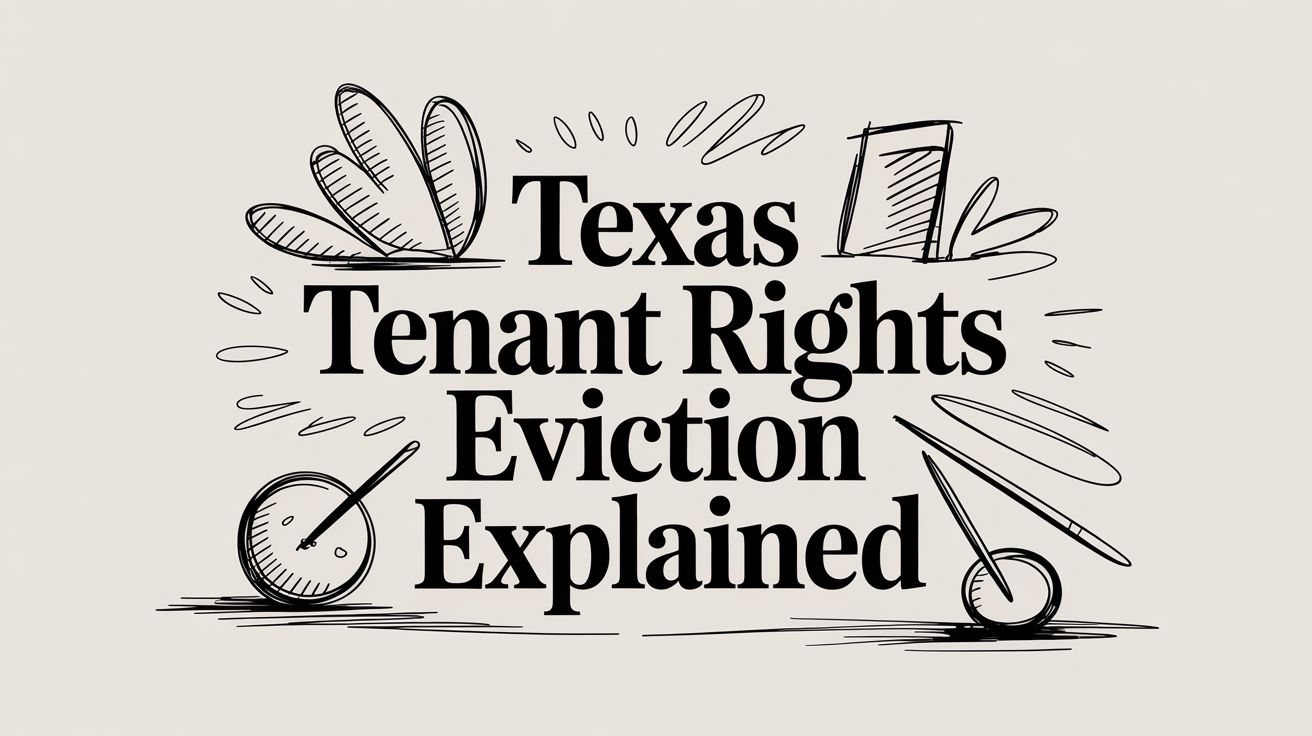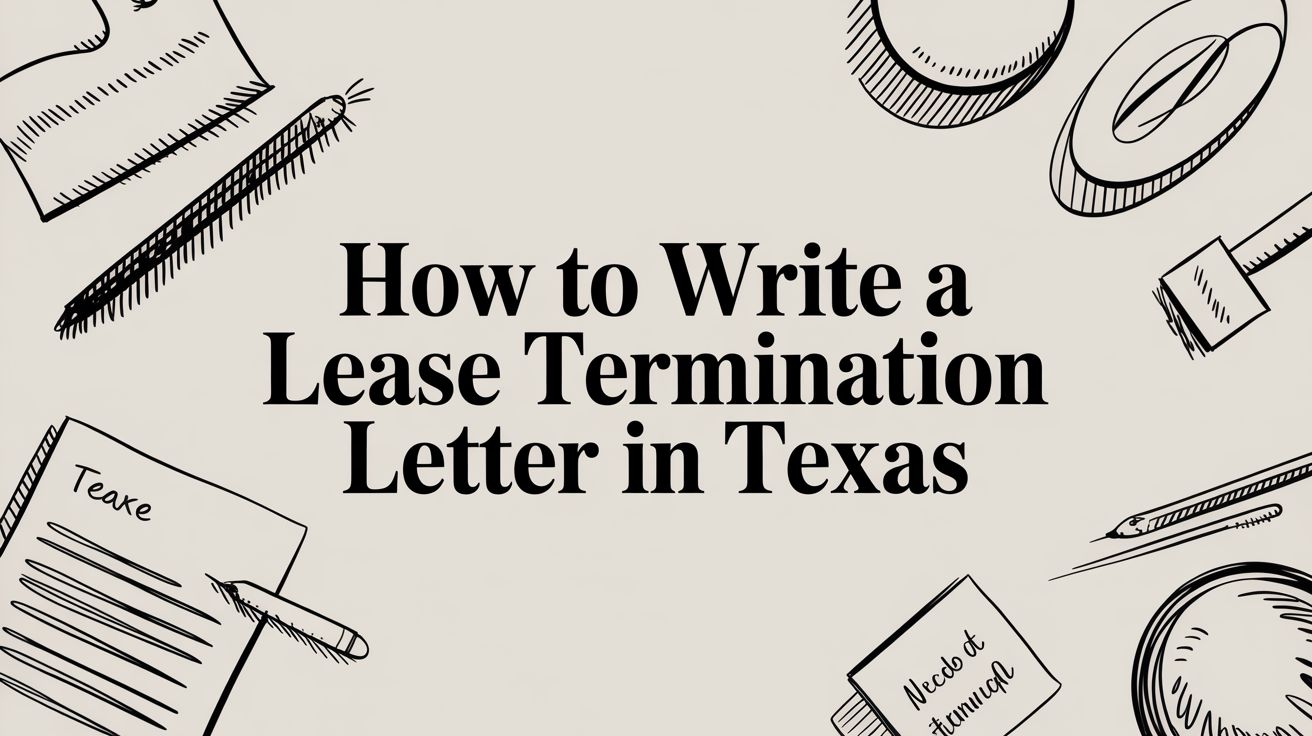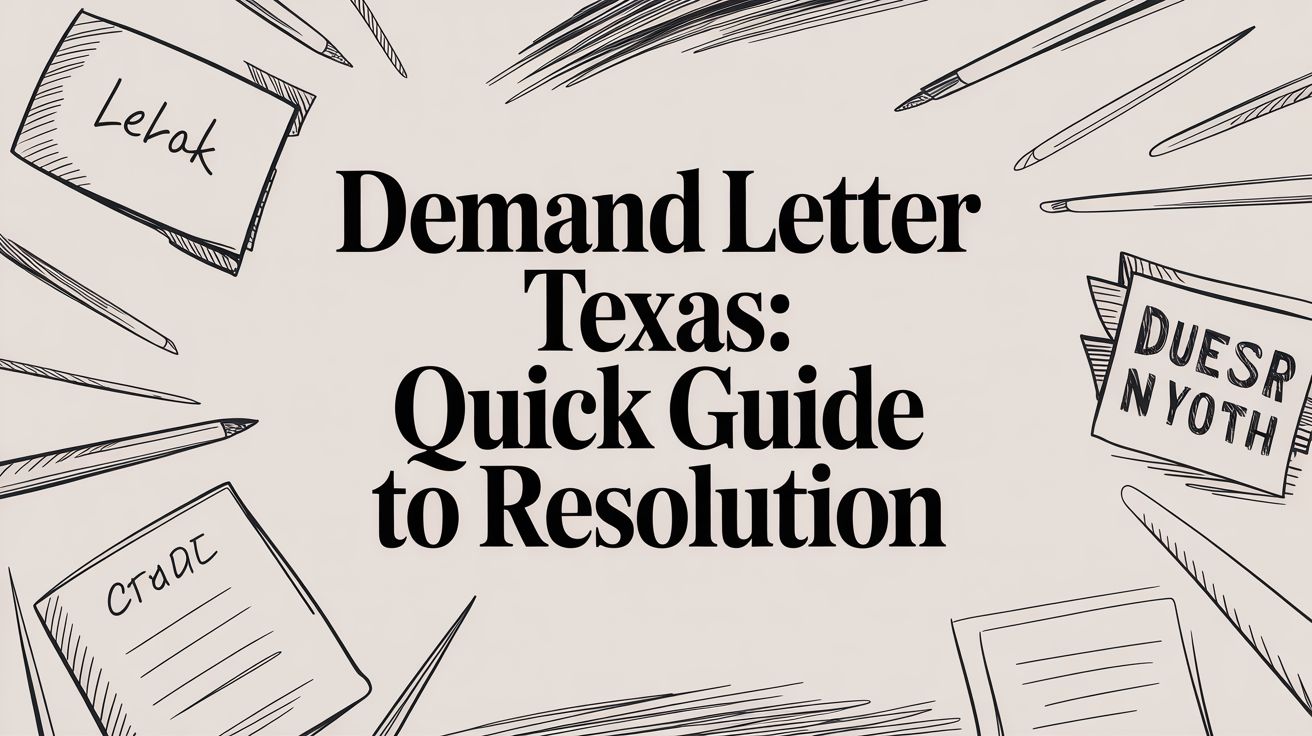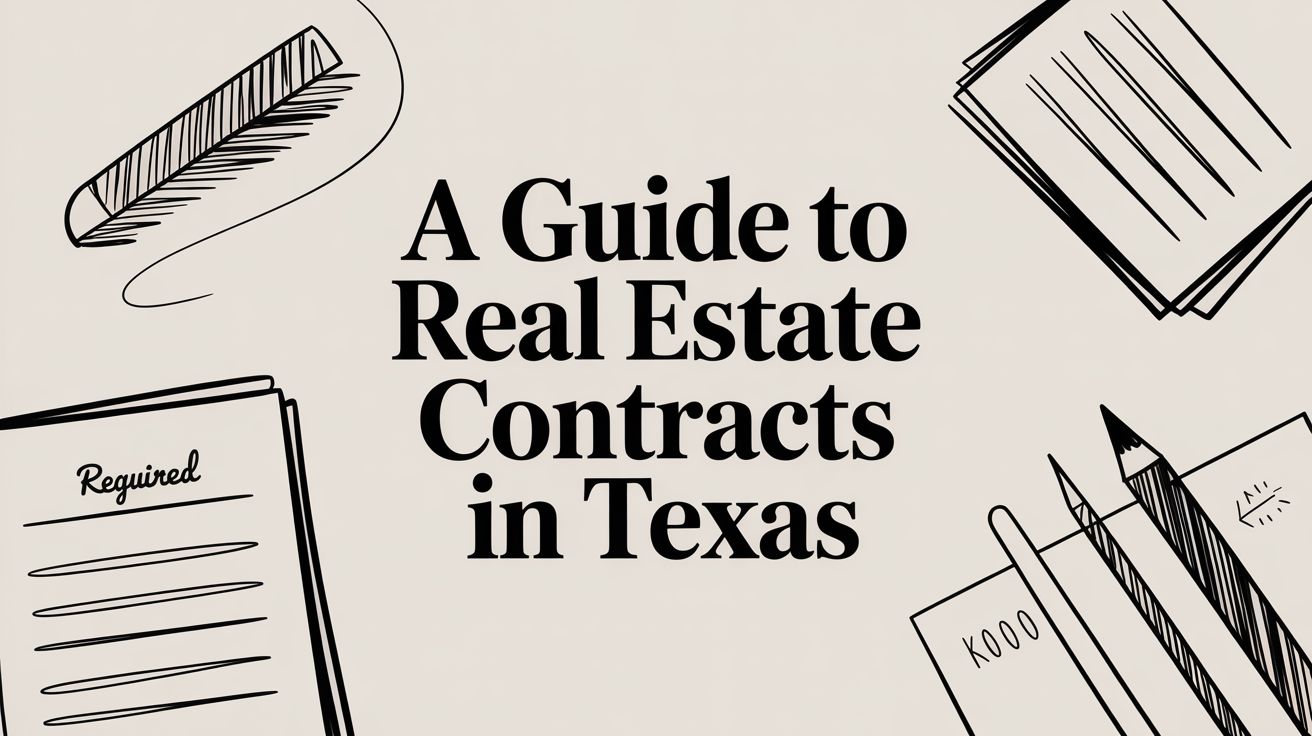Dealing with a landlord dispute or eviction can be stressful — but understanding your rights under Texas law can make all the difference. Whether you're a landlord protecting your property or a tenant facing the loss of your home, the eviction process is a strict legal path with specific rules that must be followed.
This isn't a situation where a landlord can just change the locks or toss a tenant's belongings on the curb. That's illegal. The entire process is governed by a series of precise, court-mandated steps. A typical uncontested eviction takes about three to four weeks, but one missed step or an incorrectly filed document can delay the case or even get it thrown out.
Think about a common scenario: a tenant loses their job and falls behind on rent. The landlord can't just kick them out the next day. A specific, multi-stage legal journey has to begin. Let's walk through each phase of that journey so you know exactly what to expect and how to protect your rights.
The Three Core Stages of the Eviction Process in Texas
The Texas eviction process really boils down to three main phases. Each one comes with its own set of legal deadlines and requirements that you absolutely cannot ignore, all of which are rooted in the Texas Property Code.
- The Notice to Vacate: This is the starting gun for any eviction. A landlord must give the tenant a formal, written notice to leave the property. The reason—whether it's for unpaid rent or another lease violation—dictates how much time they get. It's usually three days, but your lease agreement could change that.
- Filing the Eviction Lawsuit: If the tenant is still there after the notice period ends, the landlord's next move is to file a lawsuit in the local Justice of the Peace (JP) court. The official term for this is a "Forcible Detainer" suit, and it's how a landlord formally asks a judge to order the tenant out.
- The Court Hearing and Final Removal: Once the suit is filed, the court schedules a hearing. This is where both the landlord and tenant get to tell their side of the story to a judge. If the judge sides with the landlord and the tenant still doesn't move out, the landlord can get a "Writ of Possession." This is the final court order that gives a constable the authority to physically remove the tenant.
This infographic breaks down the typical flow of an eviction, showing how each step builds on the last.
As you can see, this is a sequential legal procedure. Getting a step wrong means you may have to start over. The reality is that these cases are becoming more common. By 2023, major Texas cities saw more than 177,000 eviction cases filed. That number is a stark reminder of the financial pressures hitting both renters and property owners across the state. Understanding these stages gives you a clear roadmap for what's ahead.
A Step-by-Step Look at the Texas Eviction Process
To give you a clearer picture, here’s a quick summary of what happens at each point in the process and which part of the Texas Property Code applies.
| Stage | What Happens | Typical Timeframe | Governing Texas Property Code |
|---|---|---|---|
| Notice to Vacate | The landlord delivers a formal written notice to the tenant, giving them a specific deadline to move out. | 3+ days | § 24.005 |
| Filing Suit | If the tenant doesn't leave, the landlord files a "Forcible Detainer" lawsuit in the appropriate Justice of the Peace court. | 1-2 days after notice expires | § 24.0051 |
| Court Hearing | Both landlord and tenant present their cases before a judge, who then issues a ruling. | 10-21 days after filing | Rule 510.6, Texas Rules of Civil Procedure |
| Writ of Possession | If the landlord wins and the tenant still won't leave, the landlord can request this final court order to have a constable remove the tenant. | At least 6 days after judgment | § 24.0061 |
Knowing these steps and their associated timelines is the first step toward navigating the process effectively. An experienced eviction attorney can help ensure every deadline is met and your rights are protected.
Step 1: Delivering a Proper Notice to Vacate
Every legal eviction in Texas kicks off with one critical piece of paper: the Notice to Vacate. If you get this first step wrong, the entire process can get derailed before it even starts, costing you valuable time and money.
This written notice isn't optional. It's the official, legally required warning that tells a tenant they need to be out by a certain date. For tenants, this document is your first and most important signal that a legal process has begun. Understanding what a valid notice requires is key to protecting your tenant rights.
What the Texas Property Code Says About Notice Timelines
Not all notices are created equal. The amount of time you get to leave depends entirely on why you are being evicted. The Texas Property Code § 24.005 sets the baseline, but your lease can actually change these timelines, so always check your lease first.
- Example Scenario: Let's say your rent was due on the 1st, and you still haven't paid by the 5th. Your landlord can serve a 3-Day Notice to Vacate. This is the standard for non-payment of rent and gives you three full days to move out before the landlord can file an eviction suit.
For other lease violations, the timeline might be longer. Say a tenant has an unauthorized pet or is causing minor property damage. In that case, the lease might specify a 30-Day Notice to Vacate. This gives the tenant a more reasonable amount of time to either "cure" the problem (like rehoming the pet) or find a new place to live.
Key Takeaway: The notice period is everything. A landlord who jumps the gun and files an eviction lawsuit on the second day of a 3-day notice period will have their case thrown out. That means starting the entire expensive and time-consuming process all over again.
What Must Be Included in a Valid Notice to Vacate
A sticky note on the door that just says "get out" won't cut it in court. To be legally valid, a Notice to Vacate has to contain very specific information.
A legally sound notice must have:
- A Clear Demand for Possession: The language must be unmistakable—it must state that you must vacate the property.
- The Reason for the Notice: It needs to spell out the grounds for the eviction, whether that's unpaid rent (and how much is owed) or another specific lease violation.
- The Deadline to Leave: This date must be accurate based on the required notice period (e.g., three full days).
- Accurate Property and Tenant Info: The property address and your name must be correct.
- A Statement on Delivery: The notice should state how it was delivered to prove the landlord followed the law.
If you are a tenant and you get a notice that's missing any of this, you might have solid grounds to challenge the eviction.
How to Legally Deliver the Notice to Vacate
How the notice is delivered is just as important as what it says. The Texas Property Code is extremely specific about the right way to do it. Simply sending a text or an email won't work.
Here are the legally recognized methods for delivering a Notice to Vacate in Texas:
- Personal Delivery: Handing the notice directly to the tenant or anyone living there who is 16 years of age or older.
- Posting on the Inside of the Main Entry Door: If nobody's home, the notice can be taped or affixed to the inside of the front door.
- Delivery by Mail: It can be sent by regular mail, registered mail, or certified mail with a return receipt requested. Using certified mail creates a paper trail proving the tenant received it.
A classic mistake is taping the notice to the outside of the door. This is almost always improper delivery and can get a notice thrown out in court. A skilled Texas landlord tenant lawyer can guide you through these strict delivery rules to make sure you get it right the first time.
Step 2: Filing an Eviction Lawsuit in Justice Court
The Notice to Vacate period has come and gone, but the tenant is still there. Now what? The next step is to file a formal eviction lawsuit, known in Texas as a “Forcible Detainer” suit, at the local Justice Court.
At this point, the dispute shifts from a private issue to a public court case. You are formally asking a judge to step in and legally order the tenant to leave your property. Every step from here on out is governed by the Texas Property Code and requires precision.
Which Court Do You File the Eviction In?
Your first hurdle is a simple but critical one: filing in the right place. In Texas, all eviction lawsuits are handled in Justice of the Peace (JP) courts. You absolutely must file the suit in the specific JP precinct where the rental property is physically located.
Filing in the wrong precinct guarantees your case will be dismissed, forcing you to pay new filing fees and start the entire process over again in the correct court. You can find the right precinct by checking your county's JP court website or calling the county clerk. It’s a five-minute task that can save you weeks of delay.
What Goes into the Eviction Petition
The heart of your lawsuit is the eviction petition. Think of this document as your formal complaint to the court. It lays out the facts: who you are, who the tenant is, where the property is, and exactly why you need them removed.
Accuracy here is non-negotiable. Your petition must include:
- Property Description: The complete, unambiguous address of the rental unit.
- Tenant Information: The full legal names of every tenant on the lease agreement.
- Reason for Eviction: A clear, factual explanation for the eviction. Is it unpaid rent? A specific lease violation? Spell it out.
- Notice to Vacate Details: You have to state that you delivered a legal Notice to Vacate and describe how you did it. Be prepared to attach a copy of that notice as evidence.
- Rent Owed: If the eviction is for non-payment, you must list the exact amount of rent currently due.
Any mistake or omission on this petition can jeopardize your case. This is where a skilled Texas landlord tenant lawyer can ensure the petition is flawless and filed correctly, setting you up for a much smoother court process.
Serving the Lawsuit to the Tenant
Once your petition is filed, the court issues a citation, which is the official notice of the lawsuit. This isn't just a piece of paper—it's a legal summons. Both the citation and a copy of your petition must be formally delivered to the tenant. This is called "service of process," and a landlord cannot do it themselves.
In Texas, only a sheriff or a constable is legally authorized to "serve" these documents. This formal delivery ensures the tenant is officially notified of the lawsuit against them and knows when and where the hearing will take place. This step is mandatory and protects the tenant's right to due process.
Real-World Scenario: A landlord files an eviction suit, but the tenant is actively dodging the constable. After several failed attempts, the landlord feels stuck. The law provides a solution. The constable can ask the judge for permission to use "substituted service," which might mean posting the notice securely on the front door and mailing a copy. This allows the case to proceed even when a tenant is uncooperative.
For tenants, getting served these papers is serious. Ignoring it won't make the eviction go away; in fact, it’s the worst thing you can do. The court will almost certainly issue a default judgment in the landlord's favor, meaning you automatically lose the case. Responding to the lawsuit is your only chance to defend yourself. Eviction filings are common, and you can explore more data on local eviction trends to get a better sense of the landscape in your area.
Step 3: Preparing for Your Eviction Hearing
This is the moment your eviction case moves from paperwork to a live courtroom. Standing before a judge can feel intimidating, but solid preparation is the best way to calmly and clearly state your case. This hearing is your opportunity to tell your side of the story to a neutral party.
The judge is focused on one simple question: who has the superior right to possess the property? These hearings are usually quick, and the judge will stick strictly to the facts directly related to the eviction itself.
The Importance of Evidence for Your Case
Walking into court empty-handed is a surefire way to lose. Both landlords and tenants must bring organized, clear evidence to back up every claim they make.
A landlord ready for court should have this packet on hand:
- The Signed Lease Agreement: The contract that outlines everyone's rights and duties.
- Rent Payment Ledgers: A clean, dated record showing what was paid, when it was paid, and what's still owed.
- A Copy of the Notice to Vacate: You must prove you delivered a legally correct notice.
- Proof of Delivery: The certified mail receipt, a photo of the posted notice, or other proof.
- Photos or Videos: If the eviction is over property damage, visual evidence is powerful.
- Communication Records: Printouts of any relevant emails, texts, or letters.
If you are a tenant, your job is to gather the same kind of evidence to build your defense. This means finding your rent receipts, taking photos of the property's condition (especially if you've been asking for repairs), and saving every text or email you've exchanged with the landlord.
Common Legal Defenses for Tenants in Texas
In the courtroom, your argument needs to be short and to the point. For a landlord, the case is usually straightforward: the tenant broke the lease, I gave them proper notice, and they still haven't left.
For tenants, Texas law provides several legitimate defenses against eviction. Just saying you couldn't afford the rent, unfortunately, isn't a legal defense. But you might have a strong case if:
- Improper Notice: The landlord’s Notice to Vacate was legally flawed or not delivered correctly.
- Landlord Retaliation: The eviction was filed right after you asked for essential repairs or reported a code violation. This is illegal under Texas Property Code § 92.331.
- Failure to Maintain a Habitable Property: The landlord has ignored your requests to fix major problems that affect your physical health and safety.
- Waiver: The landlord accepted a partial rent payment after sending the Notice to Vacate, which can sometimes cancel out the notice.
Raising one of these defenses isn't enough—you have to prove it. An experienced eviction attorney can help you determine if your situation qualifies as a legal defense and present it effectively in court. Understanding the tools available for your eviction defense is the most critical step you can take.
Example Scenario in the Courtroom:
Judge: "Mr. Landlord, please state your case."
Landlord: "Your Honor, the tenant failed to pay rent for June. I delivered a 3-day notice to vacate on June 5th by posting it on the inside of the front door. The tenant has not paid or moved out."
Judge: "Ms. Tenant, what is your response?"
Tenant: "Your Honor, I have text messages showing I asked the landlord to fix a major water leak on May 15th, and he ignored me. I told him I would withhold rent until it was fixed."
In this exchange, both sides have laid out their arguments. The judge will now ask to see the evidence—the lease, the notice, the text messages, and photos of the leak—before making a decision. Post-pandemic, eviction rates began to spike, and you can find more information about these eviction trends across Texas and how they might affect court schedules.
What Happens After the Court's Decision: Appeals and Writs of Possession
When a judge bangs the gavel, it might feel like the final chapter. But in Texas, it’s often just the start of another critical, time-sensitive process. What happens next hinges on who won and what moves each party makes in the days that follow.
The legal system gives both landlords and tenants a very brief window to challenge the Justice Court’s decision. This is where your rights are either protected or lost.
The Five-Day Appeal Period
Once the judgment is handed down, the clock starts ticking. Either the landlord or the tenant has just five days to file an appeal. This deadline is absolute. Miss it, and the court’s ruling becomes final.
Filing an appeal kicks the case up to the County Court for a complete do-over, called a trial de novo. Everything from the first hearing is wiped clean, and you start from scratch. For a tenant, this can be a strategic way to gain more time; for a landlord, it’s a chance to correct what they feel was a wrongful ruling.
However, appealing isn't as simple as checking a box. If a tenant appeals, they’ll almost always have to post an appeal bond—a financial promise to cover the landlord's potential losses, like unpaid rent, while the appeal process unfolds.
The Writ of Possession: The Final Step
Let's say the landlord wins and the tenant doesn't appeal within that five-day window. The tenant is now legally obligated to vacate. But what if they don't?
This is where the landlord’s most decisive legal tool comes into play: the Writ of Possession. This is the final court order that gives law enforcement the authority to physically remove a tenant and their belongings from the property. On day six, if no appeal is on file, the landlord can ask the court to issue the writ.
Important Takeaway: A landlord can never take matters into their own hands and physically remove a tenant. Only a constable or sheriff, armed with a court-ordered Writ of Possession, can legally carry out a forced eviction. "Self-help" evictions are illegal and will land a landlord in serious legal trouble.
What to Expect When a Writ is Issued
Once a judge signs the Writ of Possession, it’s sent directly to the local constable's office. From here, things move very quickly.
Under Texas Property Code § 24.0061, the constable must post a written warning on the outside of the property's front door. This notice is a stark alert: the writ has been issued, and the tenant has 24 hours to leave or be forcibly removed. This is the tenant’s absolute last chance to pack up and leave on their own terms.
Real-World Scenario: The Forced Move-Out
Picture this: Sarah, a tenant, lost her eviction case and didn’t appeal. On a Tuesday afternoon, she finds the 24-hour warning notice taped to her door. It’s official—a constable will return no sooner than Wednesday afternoon to execute the writ. Panic sets in as Sarah scrambles to pack. The next day, two constables arrive with the landlord. They calmly but firmly tell Sarah it’s time to go. Under their watch, her remaining belongings are moved to the curb. The landlord changes the locks, and just like that, Sarah's home is no longer hers.
This scenario shows the harsh reality of a physical eviction. It’s why understanding every deadline and right in the eviction process in Texas is so critical.
Common Questions on Texas Evictions
The eviction process can feel like a maze, so it’s natural to have questions. Here are some of the most frequent concerns we address, broken down into plain English.
Can a landlord change the locks to evict me?
Absolutely not. Texas law is very clear on this. A landlord cannot use "self-help" tactics like changing your locks or shutting off your utilities to force you out. This is an illegal lockout under the Texas Property Code. The only legal way to remove a tenant is through the formal court process. If this happens to you, speak with a Texas landlord-tenant lawyer immediately to protect your rights.
How long does a Texas eviction take?
There’s no single answer. An uncontested eviction, where the tenant moves out after getting the notice or doesn't show up to court, can be over in just three to four weeks. However, a contested case with an appeal can easily stretch on for several months. Delays in serving the lawsuit papers can also add time.
What happens to my security deposit after an eviction?
Your landlord can legally use your security deposit to cover unpaid rent and pay for property damage beyond normal wear and tear. However, they cannot just decide to keep it. The law requires them to send you a written, itemized list of every deduction they made, along with any remaining balance, within 30 days of you moving out. This is why it's so important to give your landlord a forwarding address in writing.
Key Takeaway: A landlord who keeps your deposit without a proper, itemized explanation is breaking the law. If you believe your deposit is being unfairly withheld, you might need to learn how to file a complaint against your landlord.
Can I stop an eviction by paying the rent I owe?
Sometimes, yes—but timing is everything. If the eviction is for non-payment of rent, paying everything you owe before the landlord officially files the lawsuit at the courthouse will usually stop the process. Some leases even include a "right to redeem," which lets you pay up and stay at any point before the court hearing. However, once a judge issues a judgment against you, paying the rent you owe might not be enough to stop a Writ of Possession from being executed.
If you need help with an eviction, lease issue, or rental dispute, contact The Law Office of Bryan Fagan, PLLC for a free consultation today by visiting https://texastenantlawyers.com.






![Graphic design featuring the title "8 Valid Reasons to Break a Lease in Texas [2025 Guide]" with decorative elements like a pen and paper, emphasizing tenant rights and legal guidance in Texas.](https://texastenantlawyers.com/wp-content/uploads/2025/11/featured-image-7ebe2aec-eacb-4e61-8e85-9c298b07ad11.jpg)
